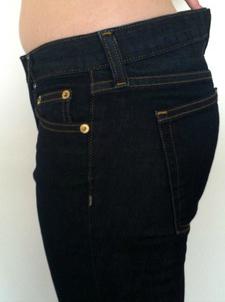How to reduce women's trousers by 2 sizes. How to sew wide trousers?
Favorite trousers are too big or don't fit fashion trends? It's not a problem, a little patience - and everything will be fine. in perfect order. Arm yourself with a needle and thread and a positive mood...
Sew the trousers along the side seams
If you need to sew in the trousers just a little, then this can be done only along one seam (inner, outer or middle), which will be easier to work with. External seams come with decorative finishing or external facial seams, it is better not to touch them when adjusting the trousers:
- First you need to rip off the edge of the trouser leg, on the side where the new seam will be, and the waistband of the trousers. The stitching should be done along the entire length of the trouser leg to avoid seam defects.
- Turn the product inside out, determine the required width of the trouser leg and, using a piece of chalk or soap, draw a line of the intended seam on both legs. This stage requires precision execution, otherwise you risk getting pant legs of different widths.
- Pin or thread the seam. Then you should try on the product to be sutured. If you are satisfied with the result, then make a line.
- Using a sewing machine, you need to trim off the excess edge and process it with an overlock or zigzag stitch.
- Sew the waistband and the bottom edge of the legs, choose a thread similar in color to your own.
- Now you can smooth the resulting seam with an iron.
We sew the trousers on both sides
If you need to sew on trousers that are a couple of sizes apart or bell-bottom trousers, you will have to work with the inner and outer seams. This is the most time-consuming method. The fitting procedure is the same as in the first case. The only difference is that you should reduce the width of the legs on both sides, transferring the measurements as accurately as possible from one leg to the other. Further:
- We rip in the right places;
- Turn it inside out and mark the seam lines;
- We baste with pins or thread, try it on;
- Sew and cut off the excess edge;
- Steam the seams with an iron.
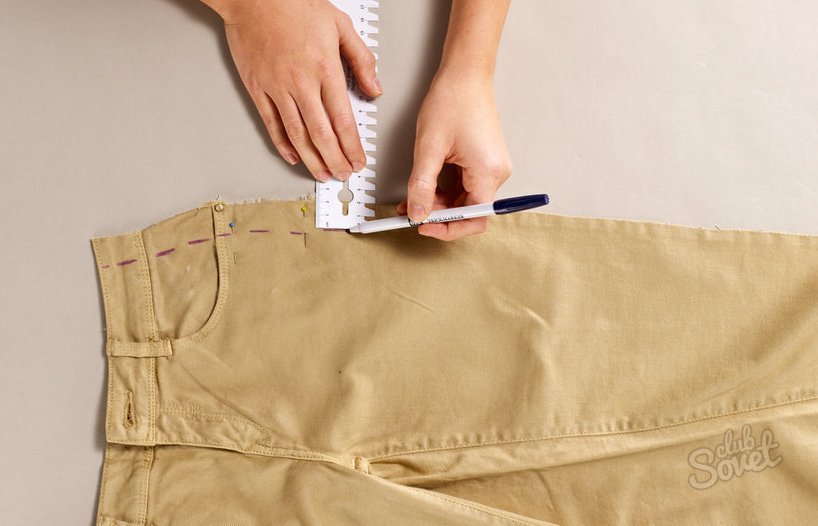
Sew the trousers along the middle seam
This fitting method is suitable if you need to reduce the size of your trousers at the waist. Initially, determine how much you will sew the trousers by basting and trying on, and then you need to:
- Undo the belt and cut it in half;
- Turn the trousers inside out and mark a new seam;
- Make a stitch and trim off the excess, trim the edges;
- Sew the belt at the required distance and sew it in its original place;
- Smooth and steam seams.

How to sew trousers in a tailor shop
If you are not comfortable with a needle and thread, then the easiest and highest quality way to give your trousers a second life is to take them to a tailor shop, where experienced craftsmen they will do everything quickly and well. This will save time and nerves for those who don't like to sew. Not only can trousers be sewn in a tailor shop, but also in clothing repair shops and seamstresses who do work at home. Take a closer look, maybe there are similar establishments near your home.
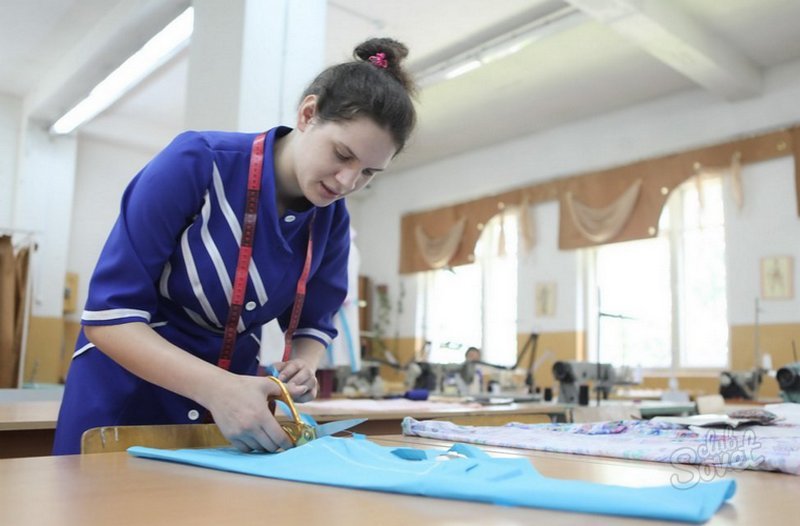
Not all trouser styles can be modified to fit well. Therefore, before you get started, consider the rationality of your choice. If you want to reduce trousers by more than 2 sizes, then it is better to buy or sew new ones, since such alteration of old ones requires a complete recut. And this is a complex job that requires special skills. Sewing trousers is not difficult with a little effort, patience and some sewing skills.
We can safely say that fashion changes almost daily. But not everyone can keep up with its trends, because a rare wallet can handle it. However, decide this problem you can just use your hands. This article will tell you how to sew in trousers and turn them into fashionable new pants.
Sewing flared trousers: preparation
First of all, let's figure out which bottoms are flared (after all, no one wears pants of this style anymore), and make them classic. To do this, you need to turn the product inside out and lay it out on a flat surface. Next, you need to decide on the width of the trouser leg itself. This is important, because this is exactly the width of the bottom of the trousers. The next step: you need to use sewing chalk (or a thin soap) to draw lines on the wrong side of the trouser leg, which indicate the location of the seam. This must be done carefully, evenly and as accurately as possible. Further along this line, the trouser legs are pinned or simply swept away. The unnecessary edge of the trousers is cut off about a centimeter from the seam.
Working on a typewriter
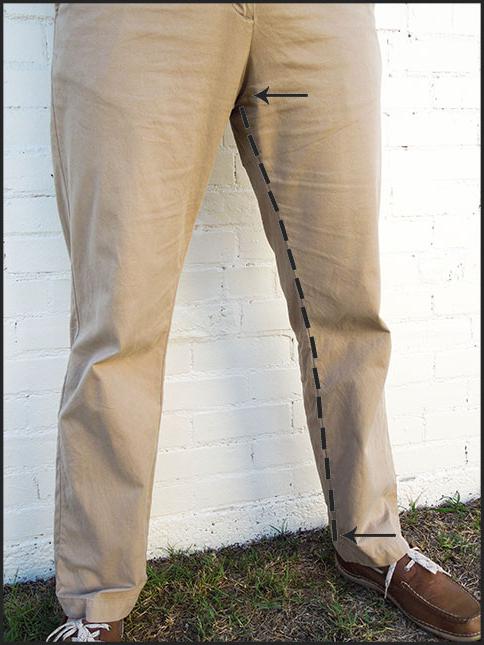
Now about how to sew trousers on a sewing machine. First of all, you need to sew a line along the drawn line, setting the stitch length as desired. Next you need to wrap the seam allowance. This can be done in different ways:
- The seams can be laid out and wrapped each separately, or they can be folded and processed together, it depends on the style of the trousers and the thickness of the fabric.
- As for the overlocker itself, if there is no such device, you can do it with a regular sewing machine. And here again there are two simple options, how to do it:
- using a special one that is found in all new machines;
- using a zigzag stitch, while setting the smallest step width.
The last one, no less important stage- iron the finished product. After steaming, the chalk line will disappear. The pants are ready!
Making tight trousers
Today, pants that are narrower at the bottom are fashionable. Of course, you can buy them, but you can do something more cunning - create such beauty with your own hands. Now we will talk about how to sew in trousers at the bottom and make them tapered. To do everything correctly, you need to perform several very simple actions, similar to the previous ones:
- First of all, you need to open the hem of the bottom so that you can work with the entire length of the pant leg.
- At this stage, it is important to decide how many centimeters the trousers will be sutured, because the method of suturing depends on this.
- If you need to narrow your pants just a little, you can do this only on one side - the outer or inner, depending on where it is easier to work with the seam (sometimes on one side it is decorative, and it is very difficult to imitate it at home).
- The principle of operation is the same as described above: you need to turn the product inside out, draw a seam line with soap (on one side), fasten the legs (with pins or basting), cut off excess fabric, stitch, and wrap the edges.
- To ensure that trousers that are tapered down to a significant width are not distorted, it is necessary to sew them in on both sides. The principle of operation is similar, however, lines are drawn near both seams, internal and external, and always at an equal distance. This is important, because otherwise the pants will look ugly.
- Bottom hem. You can lay a line or in the same place. However, today somewhat cropped trousers (on the bone) are in fashion, why not make your skinny trousers just like that?
- The last stage is ironing the product.
Belt: method one
Information on how to sew in trousers at the waist by a couple of centimeters will also be very useful. First of all, you definitely need to decide how much you need to reduce the product. Then you need to cut off the waistband on the sides so as to make small darts (their size depends on how many cm the product will be reduced by). The bottom of the darts will go into the side seams. The next step: we outline the darts and sew them with a machine stitch. As for the belt, it needs to be cut on the sides, excess fabric cut off, stitched along short sections and sewn to the product along the old lines.
Belt: method two
Is it possible to repair trousers if the item needs to be sewn down a couple of sizes? Of course! To do this, you need to undo the belt at the very beginning. They need to be sutured along the side seams along the entire length of the legs from the very top to the bottom (symmetrically on both sides). This is done as described above. If you want to significantly reduce the waist of your trousers, you will also need to sew them in along the back seam. As for the belt, excess fabric is cut off from it, and it is sewn along the upper edge of the trousers in its old place. The product is ready!
Simple rules
And now about the fact that for any repair of trousers there are certain rules:
- It should be remembered that there are different styles trousers, not all of them can be remade the way you want, and in the end, not all of them will look good.
- When cutting, you need to use ordinary household soap, this way you won’t need to wash the product, because the lines can be easily removed by steaming with an iron.
- If you need to baste, it is better to do it exclusively with white threads, regardless of the color of the pants. They do not shed because they are not colored.
- There is no need to despair if you don’t have an overlock machine at home; for this you can use the overlock foot that comes with every sewing machine, or simply work in a zigzag manner.
- When hemming trousers (especially denim ones), you need to remember that the stitching should be laid with the same stitch length as on other decorative seams.
- At the end, you must iron the product.
Sewing jeans at the waist, hips and legs at home.
When your favorite jeans become too big, you can resort to urgent repairs at home; it’s all very simple, and most importantly - economical. You will learn about all the methods of sewing trousers from the article.
How to properly sew jeans on the sides and legs?
If you have lost a couple of kilograms, or you are tired of the once fashionable flared trousers, you can easily sew them in your legs. After this home renovation, you will get fashionable skinny jeans.
To properly sew your favorite thing on your feet, you should know certain secrets:
- Put on the jeans turned inside out and mark with pins the place for sewing - it will be at the very feet, but it is better to leave 1-2 cm for shrinkage after washing
- Take off your trousers and place them on the table, straightening them out. The trousers must lie flat so that the stitching does not distort
- Arm yourself with soap white and sharpen the edge of the product - you will use it to mark the places of suturing
- To begin with, circle the area near the pins with soap, this will make the measurements more accurate.
- In the future, you will need a thread and a needle and a sewing machine, first, baste the edges of the jeans, follow the pin as a guide - the lines should go exactly along the measurements
- Try on basted jeans, if this preliminary sewing is suitable, remove the jeans and proceed to the final
- Cut off the excess part of the jeans that extends beyond the intended area and stitch the jeans on a sewing machine
- Sew the edges using an overlocker or zigzag
For the first time, the procedure may seem difficult to you, so if you have expensive jeans, you should practice on some cheaper item. But when you get good at it, carrying out such repair work will be as easy as shelling pears for you.
Video: How to sew in jeans on the sides of the legs?
How to sew jeans in at the waist?
There is such a situation that jeans fit like a glove on the hips, but at the waist they bulge unattractively. In such a situation, you should also carry out minor repairs, which, if you have a sewing machine, can be done at home, for this:
- In the case where the extra width is no more than 2-3 cm, an elastic band can save you. Buy wide elastic band, from the inside out, cut the waistband on each side of the jeans and pass the elastic along the entire length. Carefully sew the elastic to the waistband Special attention paying attention to the incision areas
- If you need to suture from 3 to 7 cm, there will be more work. First, secure the waistband at the back, between the side seams.
- Wear jeans turned inside out and ask someone you know to pin up the darts that are in the back. The main thing is that they are located evenly from the seam in the middle
- Remove the jeans and carefully sew the parts that were marked
- After this, carefully iron the stitched part
- Take threads that match the color of the main ones and fix the dart on the outside, stitching along the entire length
- Next, cut the belt, this can be done by undoing the middle loop
- Attach the waistband to the jeans and measure the excess portion that needs to be cut off
- Now you need to re-sew the already cut belt
- Re-sew the waistband to the jeans and close the seam with the belt loop.
There is another way in which you can sew in jeans, but it will take you more time and effort. But the result will be very high quality. You need to do the following:
- Open the belt loop at the back and open the waistband about 10 cm on each side of the middle seam
- Open the seam that goes between the legs (it is called the step seam) by 10 cm
- Open the middle seam, but do not unroll it, as it may move. Just carefully pin it on the front side
- Go through all the seams from the inside and also secure with pins, after which all fastenings on the front side can be removed
- Steam the seams thoroughly with an iron
- Place the legs inside each other and, 2 cm away from the middle seam, draw a line to form a triangle. The drawn line should go along the waist line
- Make a stitch along the drawn line and overcast the edge
- Sew the crotch seam from the back with one line, from the front - double
- Cut the belt in half and apply it to the stitched jeans, remove excess fabric
- Sew the waistband from the right side, iron it and align it with the trousers.
- Secure with pins and stitch carefully
Important: To ensure that the elastic is the correct length, measure yourself with it around your waist and sew the elastic into your jeans 3-5 cm less. This way, by stretching, the elastic band will be the desired length.

Thanks to this method, you can remove the excess part of your jeans that stands out unattractively at the waist. The last option will look especially high quality, but if it seems too complicated to you, use the rest. If done carefully, the result will definitely be of high quality.
Video: Sewing jeans at the waist
How to sew jeans a size smaller?
Reset extra pounds Of course, it’s very uplifting, but it also causes wardrobe problems. If your jeans have become too big for you, then this can be corrected, especially if the reduction is only one size:
- The most in a simple way is washing. Exhibit in washing machine temperature equal to 95C and send the jeans to a hot wash. This process should be repeated twice, and make sure that cold water does not penetrate the jeans.
- When setting the machine to the cold rinse mode, stop the process. Dry washed trousers on a hot radiator or using a steam dryer. This method is quite good, but after a certain time the jeans may stretch again, so you will have to repeat the procedure again
- Another method is suturing. If your jeans are too big at the waist and hips, sew them in at the side. To do this, turn the jeans inside out and mark with a pin the places that need to be cut.
- Walk along the jeans with soap, break off the pins and mark the places for the new stitching with thread. Put the jeans back on and if they now fit well, trim off the excess fabric and stitch the pants
- If the jeans are just right in the hips and there is a lot of excess fabric in the waist, it’s not a problem, sew in the pants along the seam that is located at the back. Open the belt loop and cut the belt in the middle
- You need to make darts on each side - there you will hide excess material. Do not make very long darts, as this may cause unsightly folds on the back pocket.
- When you have removed everything unnecessary, sew the belt to the jeans and return the belt loop
- A very simple way is to sew jeans using the side seams. In these places you need to make darts; to do this, open the stitching that runs along the side seams
- Next, carefully place the excess fabric under the side seams and stitch the jeans together again. This option is suitable if you have a high-quality machine or thin jeans, since the side seams are quite tight

If your jeans are a size too big, it is very easy to adjust them to fit you thanks to these methods. Don't forget about your favorite thing, everything can be fixed.
Even if the trousers are too big in one particular place, you can pay attention and correct this particular part of the jeans. You should not contact workshops - you will spend a decent amount there.
At home, if you follow these recommendations, you will carry out repair work like a real seamstress. Moreover, you are doing this kind of work for yourself, which means you will definitely do everything carefully and conscientiously.
Video: How to sew jeans along the side seams?
You don't have to be a professional dressmaker to do this. It is enough to use their techniques and in just an hour and a half you can get excellent results.
What will you need for this? Sewing machine, iron with steamer, ruler, chalk, scissors, needle, matching thread and tailor's ripper and pins.
How to taper your pants correctly
To narrow it down women's pants like the pros do, you shouldn’t make the mistake that almost all beginners make. You will have to remove unnecessary width not only from the side seams, but from the inside seams, while maintaining the symmetry of the existing cut. Otherwise, achieving a perfect fit is simply impossible. And do not neglect intermediate steps - such as basting or steaming, only in this case, the result of the work will please you.
So. Turn the pants inside out and carefully open the hem, then open the side and inseams. If you are tapering your trousers along the entire length, it will not be a bad idea to rip out part of the crotch seam. Then steam the seams properly and let the fabric dry.
Now start marking. Measure along the bottom edge of the trouser leg the width you need, but be sure to maintain symmetry, retreating an equal number of centimeters from the edges. Now swipe your chalk thin line from the markings on the bottom edge to the hip line, repeating the direction of the original seams.
It is necessary to make a basting along the intended line - with small, neat stitches, making sure that the front and back panels do not move. For reliability, they can be fastened with simple tailor's pins.
How to make tapered pants
After you have swept the model, you must try it on. Put on your trousers and carefully examine the result of the work - you can correct it at this stage. Properly tapered trousers should fit like a glove. The easiest way to achieve this is if the fabric contains elastane, it will provide plasticity and good fit. But you need to pay special attention to natural cotton or wool, in which case a good fit will have to be achieved through precisely laid seams.
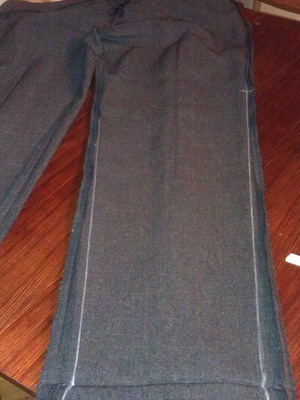
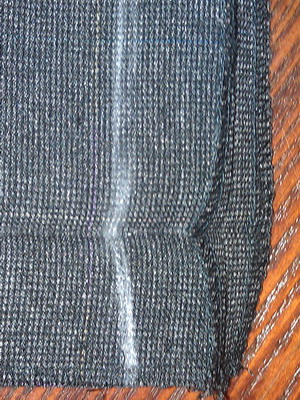
Professional dressmakers use when trying on simple trick, allowing you to perfectly fit the item to your figure. Put your trousers on inside out and you'll see exactly where you can trim and where you need to add more.
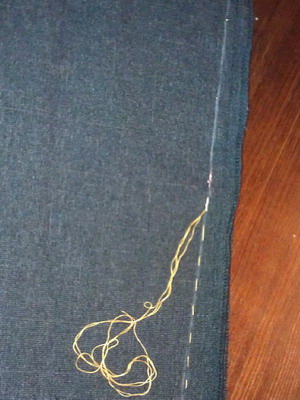
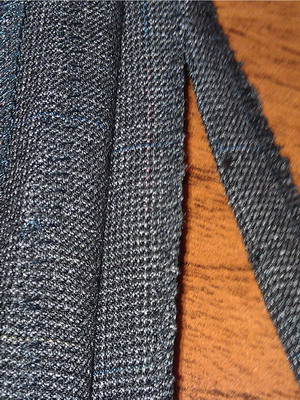
If you are satisfied with the result, all that remains is to sew the seams along the basting, get rid of it and carefully finish the edges. Cut off all excess, stepping back one and a half centimeters from the new seams. If you do not count on the accuracy of your eye, carry out auxiliary line and cut along it. Now the edges must be processed using an overlocker or a zig-zag seam and the seams carefully smoothed out.


Fold the hem under the bottom without changing its width and secure it carefully with a blind or velvet seam. Your new tapered trousers were made like in the best tailor!
How to Taper Dress Pants
To turn any model into stylish “cigarettes” or “pipes” you need to take into account several professional nuances. Wide from the hip and throughout the valley classic pants you can narrow it as you want using basic techniques described above. But before you get down to business, keep in mind that such models should be sewn in strictly repeating the silhouette lines.
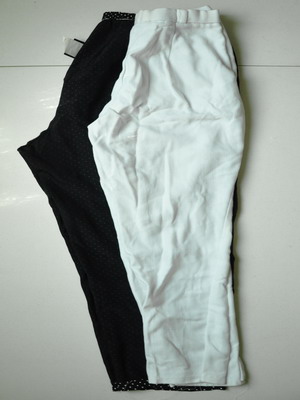
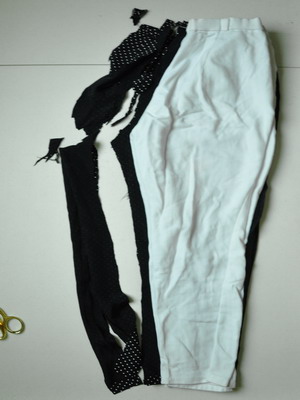
When complex models and a thorough alteration, be sure to open the crotch seam; it is easy to restore it by laying a double stitch along the same lines at the end of the work. This way you can proportionally reduce the volume in the hips and get rid of unattractive creases and folds.
To ensure that the silhouette of the finished model fits your figure exactly, be sure to mark the knee line even at the marking stage. To do this, measure the distance from it to the waist - it is different for each figure - and set it aside from the model’s belt. This tag will make it possible to find correct position new seams, now smoothly connect it with the marks on the bottom edge.
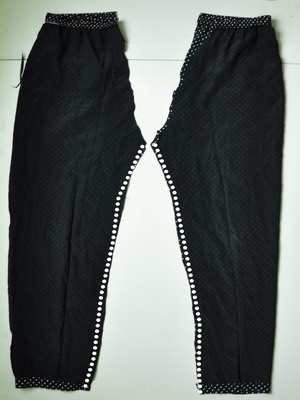

This is especially important if you want to tape your pants at the bottom like banana or cigarette styles. Measure the volume of your knee with a measuring tape, divide it in half and add 2-3 centimeters for the freedom of fit. Place this length strictly symmetrically along the knee line and draw smooth line to the model's waist.
The width of the model at the hips can be adjusted to your own parameters. But the width of the bottom edge in this case should remain no more than 15-18 centimeters. Set it aside in the same strictly symmetrical manner relative to the side and internal seams and sweep it carefully. It is these proportions that will ensure the desired fit and excellent fit.
Probably many are familiar with the situation when you need a sewing machine, it seems, and your hands grow out of the right place, but there are not enough skills? You can, of course, turn to the studio for help, but why then is this “Singer” or “Janome” standing in the room collecting dust? Of course, no one argues that it is more difficult to sew pants than a skirt or dress, but it is quite possible, the main thing is to follow our recommendations.
How to properly sew pants?
This is only at first glance, it seems that it is easy to sew in the sides and waist of the trousers. But there are a number of nuances here. The main nuance– this means you can sew up trousers no less than two sizes. Otherwise, you may warp the trouser legs and ruin the model.
If you see that you need to sew in more, then full cutting cannot be avoided. That is, rip apart at the seams, apply new patterns and make a pattern for them. Therefore, it is worth soberly assessing your strengths, and in order to avoid damage to the product, consider the option of handing over the trousers to the atelier.
The second point is that the trouser legs need to be sutured simultaneously along all seams: back, side and inside. Note! We will suture only on the outside if we need to remove excess tissue from the hips, and not the entire size. That is, when the product is your size, but does not fit well on the hips because there is not enough volume.
Before picking up scissors and a needle, you first need to turn the product inside out and put it on yourself. Mark with pins the places where the model sits imperfectly. Then baste by hand and try on the front side. If what you see satisfies you, you can sew a machine seam.
If the trousers are a little wide, there is no need to rush and rather start stitching the side seam. First, try on your pants, pin up the outer seam, and move around in them a little, sit down. If you feel that they are “pulling”, most likely the inner stitching needs to be redone.
But in any case, before you take up the machine, first try on the trousers and determine exactly where you need to remove the excess. This is exactly the case when they say “ Measure seven times, cut once».
How to sew wide trousers in the waist and sides?
There are several ways you can wear a belt, choose one of them:
- Sew only the side folds;
- Sew by making undercuts;
- Remove excess fabric by suturing the middle seam;
Below step by step description how to sew in trousers 1-2 sizes in the waistband, processing the middle seam:
- First, open the belt loop, then the belt and cut it in half (at the back). Next, open the finishing stitch on the middle seam (on the butt). Then the seam itself is sutured;
- Then the excess is removed from the belt. It is sewn together, the decorative stitching and belt loop are restored on the middle seam.
How to sew in trousers only on the sides?
- The product is also put on inside out and all excess fabric is measured in front of the mirror, on the hips, butt and legs;
- Then make temporary stitches on one leg and try on the product again, comparing both legs;
- If everything is basted correctly, then take off your pants again, place unnecessary stitches on them, then sew everything along the marked lines. In order to preserve the model, it is necessary to sew all seams equally - internal and external;
- Trying again. If everything is satisfactory, then the trousers are ironed, excess allowances are cut off and the edges are overcast.
How to properly sew women's flared trousers?
Sometimes the trousers fit perfectly at the top, but the cut at the bottom doesn't suit you.
And it’s not just about flares, which are now unfashionable, sometimes you want to narrow the usual straight model:
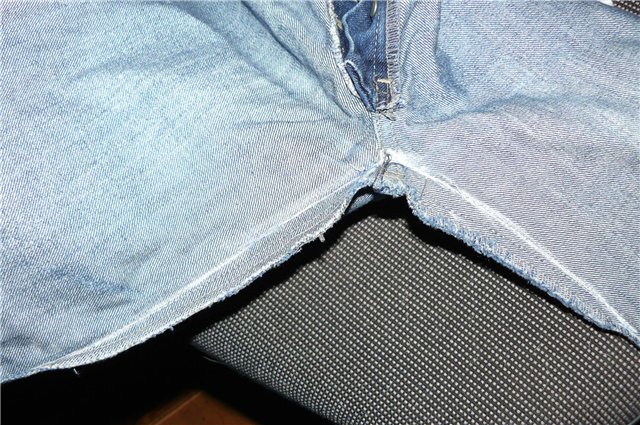
- It all starts, as usual, with fitting. We put the product on inside out and pin the excess with tailor's pins. Everything is done on one pant leg. On it we measure the same distance on the fabric from both seams;
- We take off our pants and, using soap, draw an even (straight or tapering) line from the highest pinned point downwards;
- Then we combine both legs and from one to the other we also transfer the line of the new stitch with pins. We also draw a line on the second trouser leg with soap;
- We sew by hand and do fittings. If the stitch line suits you, then cut off the excess fabric at a distance of 1 centimeter from the seam and sew the legs;
- Iron the pants and overcast the edges.
How to sew pants at the bottom?
It will be easier to use a lifesaver in the form of tailor's adhesive tape. To do this, first determine the bend line. Then we cut off the excess fabric. You need to leave from 1 to 2.5 centimeters. Afterwards, the fold line is fixed with an iron.
Next, a ribbon is inserted into it, you can insert it in parts and each part is ironed from the inside out. After the tape is fixed, make a circular stitch at the bottom of the pant leg, otherwise it may come off during washing.
There is also a method without tape. Using it we again determine the length finished product. Leave a seam allowance of 1 centimeter and cut off the excess. We overlock or overcast the edge, and then on the wrong side we make a fixing stitch on the machine.
Rules for sewing trousers 1-2 sizes smaller
There are basic rules that should be followed when sewing in trouser legs. And it doesn’t matter whether you remove the size or the flare:

- Not all styles can be altered;
- When cutting, use ordinary household soap;
- The basting is done with white thread, as it does not fade;
- If there is no “overlock”, process the edges with a “zigzag” or use a special attachment called “ overlock foot»;
- You need to sew the trouser legs starting from the top;
- If the pants have decorative seams, such as on jeans, then even the inner stitches are laid with the same stitch length as the decorative one;
- Don't forget to iron the product at the end.
As you can see, there is nothing complicated in the question of how to sew in even wide trouser legs. The main thing is not to rush. Until the final stitch is done and the excess fabric is cut off, you will always have the opportunity to undo the threads and re-stitch. Happy sewing.


